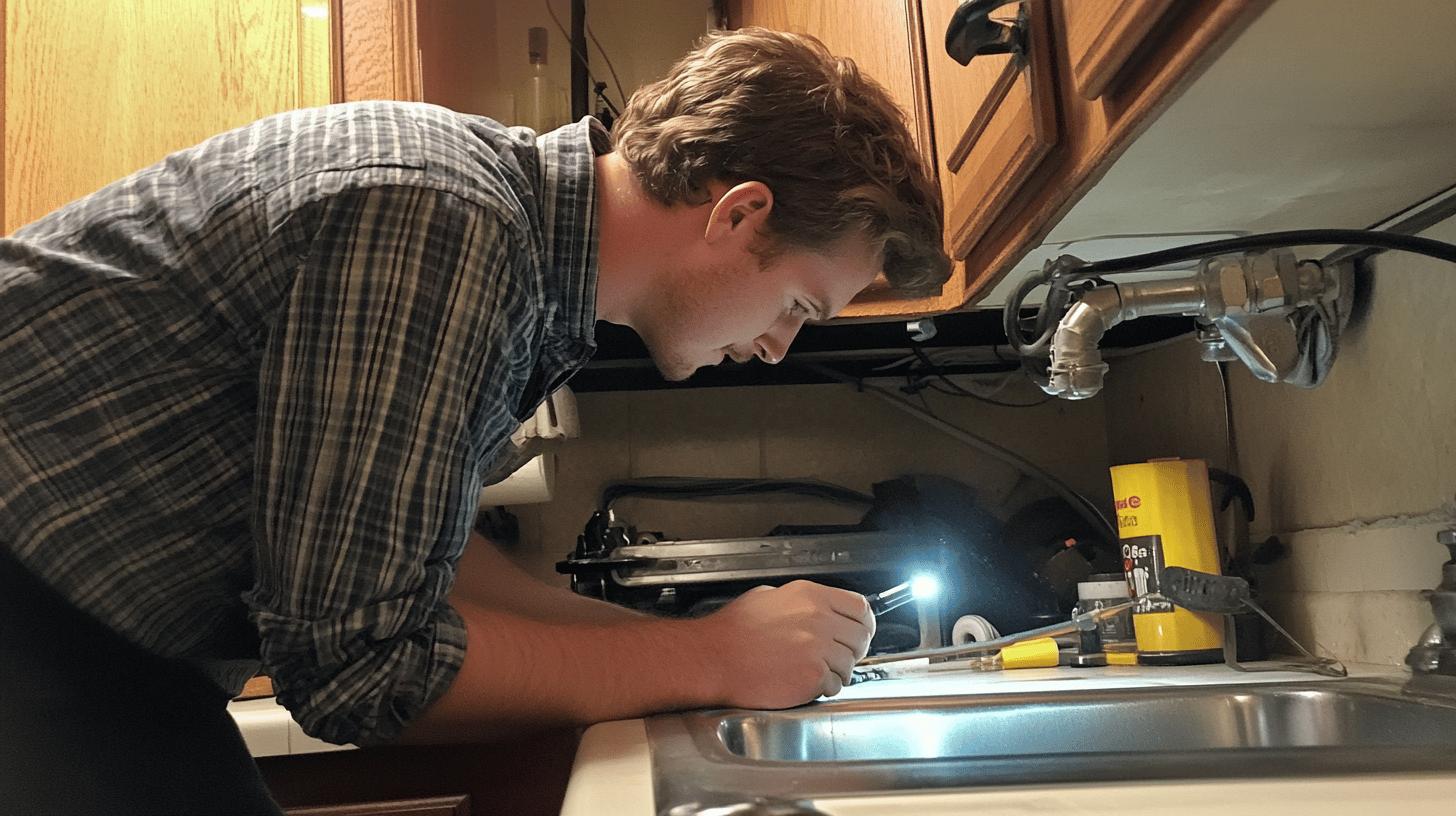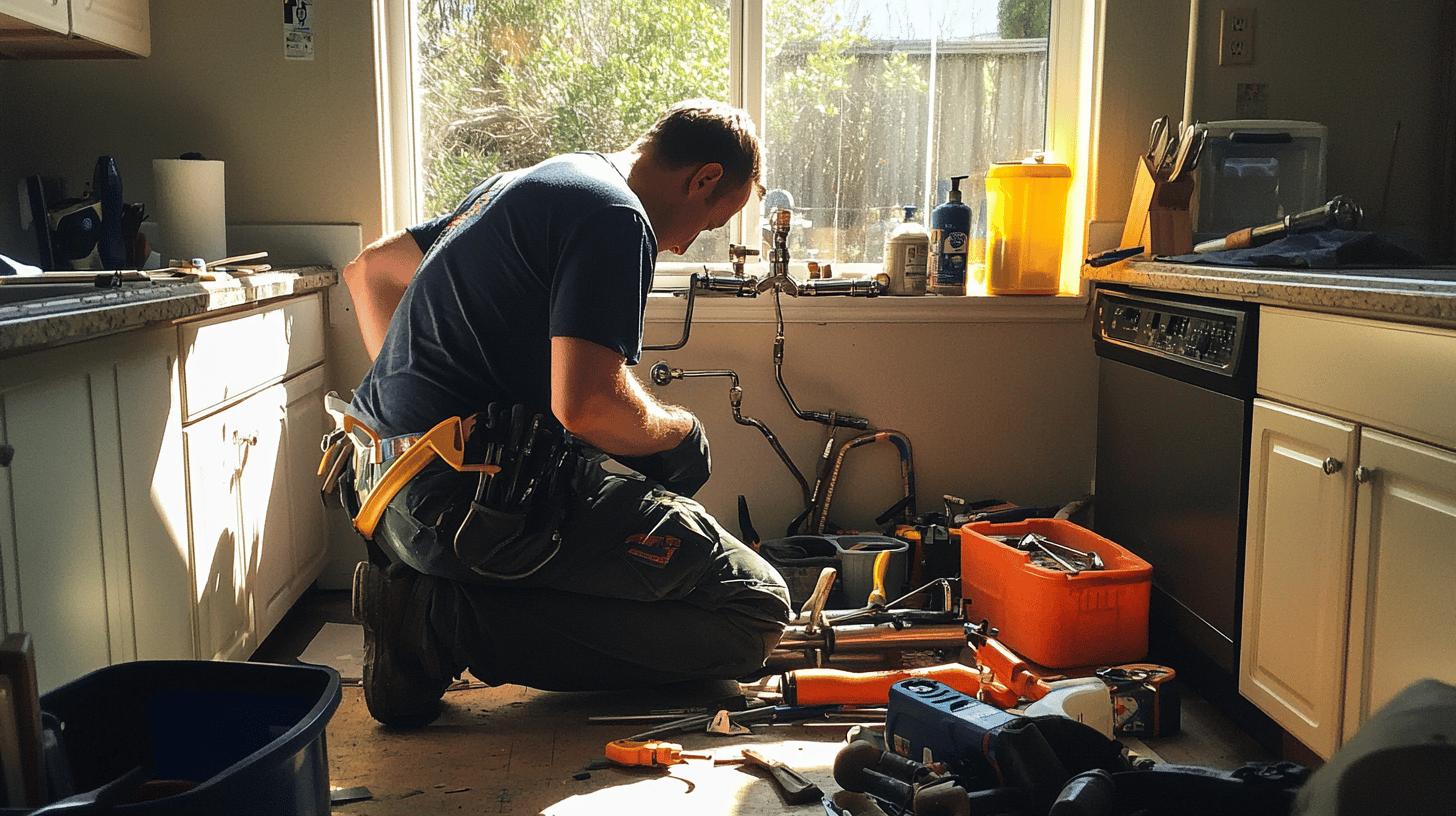TL;DR:
- Plumbing Components: Water supply, DWV system, fixtures, and pipes.
- Pipe Materials: PVC (lightweight, corrosion-resistant), Copper (durable, expensive), Galvanized steel (strong, prone to corrosion).
- Types of Valves: Gate, Ball, Check, Pressure-Reducing, Butterfly.
- Water Heater Types: Tankless (on-demand), Electric, Gas.
- DWV System: Includes drain pipes, traps, and vents to remove wastewater and block sewer gases.
- Maintenance Tips: Unclog drains, inspect pipes for leaks, drain water heaters, insulate pipes in winter.
- DIY Issues: Clogged drains (hot water + baking soda + vinegar), running toilets (replace flapper).
- Professional Help Needed For: Gas smells, major leaks, sewer line issues, sump pump maintenance.
Ever wonder what keeps the water flowing in your home? Knowing the basics of your plumbing system can save you time and money. Plumbing systems have key parts like water supply lines, drain-waste-vent systems, fixtures, and pipes, all working together. In this article, we’ll explain each part, how they work, and why they’re important for keeping your home running smoothly. Ready to dive in? Let’s get started!
Plumbing System Basics: Key Components and Their Functions
Understanding the key parts of a plumbing system is super important. The system includes the water supply, drain-waste-vent system, fixtures, and pipes. Each part helps move water and waste efficiently in your home.
Pipes are the backbone of the plumbing system, delivering clean water and removing wastewater. Common pipe materials include PVC, copper, and galvanized steel. PVC pipes are lightweight and corrosion-resistant, making them great for homes. Copper pipes are durable and last a long time, but they can be pricier. Galvanized steel pipes are strong but can corrode over time and are usually found in older homes.
Types of Valves in Plumbing
- Gate Valves: Used to start or stop water flow.
- Ball Valves: Offer precise control over water flow with a simple turn.
- Check Valves: Prevent backflow, ensuring water flows in one direction.
- Pressure-Reducing Valves: Control water pressure to prevent damage to the system.
- Butterfly Valves: Provide quick shut-off and are commonly used in industrial applications.
Fixtures like sinks, toilets, showers, and faucets are essential parts of your plumbing system, made from materials like porcelain, chrome, or stainless steel. They give you access to water in your home.
Water heaters are also important, as they heat water for these fixtures. You can choose from tankless, electric, and gas heaters. Tankless heaters provide hot water on demand, while electric and gas heaters store water in a tank, keeping a steady supply of hot water ready for use.
Understanding the Water Supply System in Plumbing

The water supply system brings fresh water into your home. It relies on water pressure to maintain a steady and sufficient flow through the pipes.
Key Components in Water Supply
- Pipes: Transport water.
- Fittings: Connect different sections of pipes.
- Valves: Control water flow.
- Water Meter: Measures water usage.
- Pressure Regulator: Maintains optimal water pressure.
Pipes can wear out over time and might need maintenance or replacement. Fittings connect different sections of the pipes, keeping the system leak-free. Valves let you turn off the water to specific areas for repairs or emergencies.
Water meters, usually found outside, measure how much water you use, helping you spot leaks and manage your water consumption. Pressure regulators protect the plumbing system by maintaining the right water pressure, preventing damage to fixtures and appliances from high-pressure surges.
Plumbing Drainage System: How It Works
The drain-waste-vent (DWV) system is crucial for getting rid of wastewater in your home. It includes drain pipes, drain traps (like P traps), and drain vents, all working together to make sure wastewater flows out smoothly while keeping sewer gases from coming back in.
Key Aspects of DWV System
- Drain Traps: Hold a small amount of water to block sewer gases from entering your home.
- Drain Vents: Introduce air into the plumbing system to maintain proper pressure, ensuring that water and waste can flow freely.
Common clog issues include:
- Hair clogs in bathrooms
- Grease clogs in kitchens
- Vent blockages
- Trap siphoning
Regular inspections by a licensed plumber can catch potential problems before they get serious. Plumbers can also clear any buildup in your pipes to keep your DWV system running smoothly. If you ignore maintenance, you might end up with slow drains or even total blockages, which can be expensive and inconvenient to fix.
Basic Plumbing Maintenance Tips for Homeowners

Regular plumbing maintenance is essential for preventing major problems and extending the life of your system. Keeping up with maintenance can help you avoid expensive repairs and ensure everything runs smoothly.
Basic Maintenance Tasks
- Unclog Slow Drains: Use a mixture of hot water, baking soda, and vinegar.
- Inspect Pipes for Leaks: Especially in areas prone to moisture.
- Drain Water Heaters Biannually: Remove sediment buildup.
- Insulate Pipes During Winter: Prevent freezing and potential bursts.
- Use Strainers and Enzyme-Based Cleaners: To avoid clogs.
Some tasks are better handled by professionals. Regular check-ups by licensed plumbers can spot potential problems early and keep your system in top shape. They have the expertise to tackle complex issues, making their services a smart investment in your home’s plumbing health.
Common Plumbing Issues and When to Call a Professional
Many common plumbing issues can be fixed with simple DIY methods. For instance, clogged drains often clear up with a mix of hot water, baking soda, and vinegar. Running toilets, which are another common problem, are usually caused by a faulty flapper.
DIY Solutions
- Clogged Drains: Pour hot water down the drain, followed by baking soda and vinegar. Flush with more hot water.
- Running Toilets: Replace the worn-out flapper.
When to Call a Professional
- Gas Smells: Possible gas leak.
- Major Leaks: Significant water damage potential.
- Sewer Line Issues: Can lead to severe health hazards.
- Sump Pump Maintenance: Prevents basement flooding.
Professional plumbers have the right tools and expertise to diagnose and fix issues quickly and accurately. Trying to tackle big plumbing problems yourself can often lead to more damage and expensive repairs. Trusting a professional ensures the job is done right the first time, saving you time, stress, and money in the long run.
Final Words
By diving into the basics of plumbing systems, you’ve learned about key components like pipes and water heaters. We covered how the water supply system works and the roles of pipes, fittings, and valves. We also looked at the drainage system, its important parts, and common problems. Basic maintenance tips were shared to help keep your plumbing in great shape.
Knowing when to call a professional for tougher issues is essential. Understanding these fundamentals gives you the confidence to manage your plumbing system and keep it running efficiently.
FAQ
What are the plumbing basics?
Plumbing basics include understanding the water supply system, drain-waste-vent system, fixtures, and pipes. These components work together to bring fresh water in, distribute it, and remove wastewater.
What are the three types of plumbing systems?
The three types of plumbing systems are the water supply system, drain-waste-vent (DWV) system, and the fixtures system. Each serves a crucial role in managing water and waste in a building.
How does a plumbing system work?
A plumbing system works by bringing fresh water into the home through a water supply system, distributing it to various fixtures, and removing wastewater through the drain-waste-vent (DWV) system.
What are the three basic components of a household plumbing system?
The three basic components of a household plumbing system are the water supply system, the drain-waste-vent system, and fixtures like sinks, toilets, and showers. These work together to ensure smooth water flow and waste removal.

